Ditapis dengan
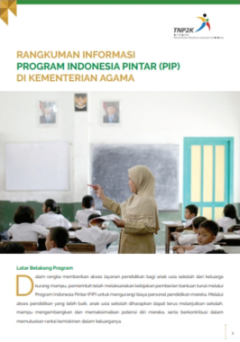
Rangkuman Informasi Program Indonesia Pintar (PIP) Di Kementerian Agama
Dalam rangka memberikan akses layanan pendidikan bagi anak usia sekolah dari keluarga kurang mampu, pemerintah telah melaksanakan kebijakan pemberian bantuan tunai melalui Program Indonesia Pintar (PIP) untuk mengurangi biaya personal pendidikan mereka. Melalui akses pendidikan yang lebih baik, anak usia sekolah diharapkan dapat terus melanjutkan sekolah, mampu mengembangkan dan memaksimalkan p…
- Edisi
- 1
- ISBN/ISSN
- -
- Deskripsi Fisik
- PDF, 12 Halaman
- Judul Seri
- Policy Brief
- No. Panggil
- 361.1 TNP. R
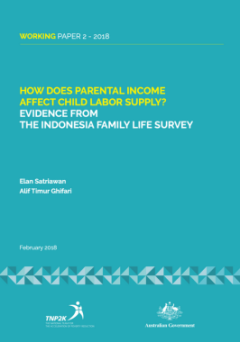
How Does Parental Income Affect Child Labor Supply? Evidence from The Indones…
Drawing on the substitution axiom formulated by Basu and Van (1998) this study examines the nature of relationship between parental income and child labor supply in Indonesia. To estimate such relationship, we are benefited by panel data from the last two waves of Indonesia Family Life Survey (2007 and 2014). We tackle the potential endogeneity in parental income by controlling for parental fix…
- Edisi
- Working Paper 2 - 2018
- ISBN/ISSN
- -
- Deskripsi Fisik
- PDF, 30 Halaman
- Judul Seri
- Working Paper
- No. Panggil
- 362.71209598 SAT. H
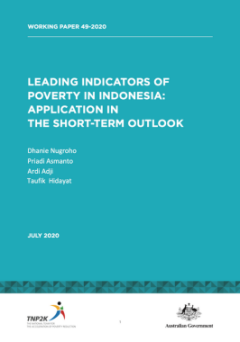
Leading Indicators of Poverty in Indonesia: Application in The Short-Term Out…
Development indicators operate very dynamically in line with the government’s program and policy response. The government, therefore, needs an estimate of the poverty rate for a specific period in line with the development of its constituent indicators. The rate is required by the government to ensure the implemented policy can achieve the target according to the plan. Given the available ind…
- Edisi
- Working Paper 49-2020
- ISBN/ISSN
- -
- Deskripsi Fisik
- PDF, 36 Halaman
- Judul Seri
- Working Paper
- No. Panggil
- 362.509598 NUG. L

Towards Spatial Poverty Targeting: Identification of Poverty Clustering in In…
The Government of Indonesia is facing a new challenge in tackling poverty since the pace of the fall in the poverty rate has been slowing over the five years to 2020. To date, poverty alleviation programs implemented by the Government of Indonesia have been limited to large administrative areas such as the district (kabupaten) level. For this study, we combined the Poverty Livelihood Map of …
- Edisi
- Working Paper 53-e - 2020
- ISBN/ISSN
- -
- Deskripsi Fisik
- PDF, 22 Halaman
- Judul Seri
- Working Paper
- No. Panggil
- 362.509598 CAH. T

Harmonisation of Susenas and Riskesdas
To succeed in implementing programs to reduce the number of stunted children, accurate and timely data and information are required to serve as the basis for target and goal setting. The use of Riskesdas (Riset Kesehatan Dasar: Basic Health Research) is highly important to generate indicators on the Indonesian people’s health status and monitor the success of various government programs in th…
- Edisi
- Working Paper 43 - 2019
- ISBN/ISSN
- -
- Deskripsi Fisik
- PDF, 20 Halaman
- Judul Seri
- Working Paper
- No. Panggil
- 362.109598 ADJ. H
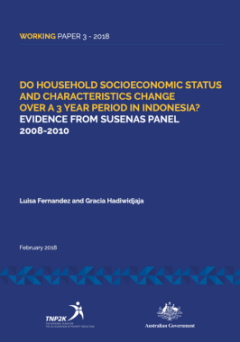
Do Household Socioeconomic Status And Characteristics Change Over A 3 Year Pe…
Database used to target social programs in Indonesia was updated every three years. Exclusion error and poverty dynamics in Indonesia have raised the question whether updating is required within that three year period. In this paper, we assess this issue by employing Susenas panel data to track changes in household characteristics and consumption mobility within three years. We find that househ…
- Edisi
- Working Paper 3 - 2018
- ISBN/ISSN
- -
- Deskripsi Fisik
- PDF, 34 Halaman
- Judul Seri
- Working Paper
- No. Panggil
- 330.9598 FER.D
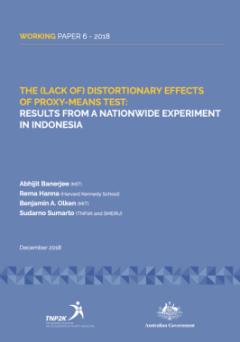
The (Lack Of) Distortionary Effects Of Proxy-Means Test:Results From A Nation…
Many developing country governments determine eligibility for anti-poverty programs using censuses of household assets. Does this distort subsequent reporting of, or actual purchases of, those assets? We ran a nationwide experiment in Indonesia where, in randomly selected provinces, the government added questions on flat-screen televisions and cell-phone SIM cards to the targeting census admini…
- Edisi
- Woking Paper 6 - 2018
- ISBN/ISSN
- -
- Deskripsi Fisik
- PDF, 36 Halaman
- Judul Seri
- Working Paper
- No. Panggil
- 330.9598 BAN.T
 Karya Umum
Karya Umum  Filsafat
Filsafat  Agama
Agama  Ilmu-ilmu Sosial
Ilmu-ilmu Sosial  Bahasa
Bahasa  Ilmu-ilmu Murni
Ilmu-ilmu Murni  Ilmu-ilmu Terapan
Ilmu-ilmu Terapan  Kesenian, Hiburan, dan Olahraga
Kesenian, Hiburan, dan Olahraga  Kesusastraan
Kesusastraan  Geografi dan Sejarah
Geografi dan Sejarah